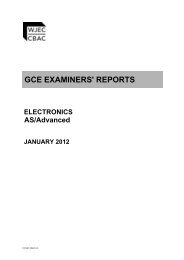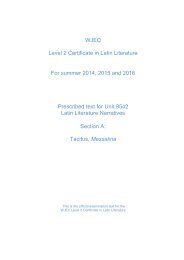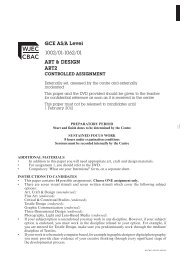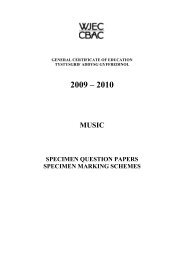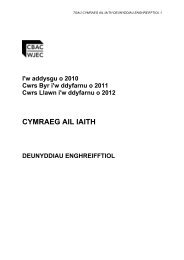WJEC ENGLISH LITERATURE
WJEC ENGLISH LITERATURE
WJEC ENGLISH LITERATURE
You also want an ePaper? Increase the reach of your titles
YUMPU automatically turns print PDFs into web optimized ePapers that Google loves.
How do Kate Chopin and Anne Bronte use their protagonists to critique the<br />
position of women in conventional 19 th Century marriages?<br />
Both Edna in ‘The Awakening’, and Helen in ‘The Tenant of Wildfell Hall’ defy expectations<br />
of the stereotypical Victorian woman. During the reign of Queen Victoria, a woman’s place<br />
was considered to be in the home. A good and virtuous woman’s life revolved around the<br />
domestic sphere of the home and family; she was expected to be diligent and pious.<br />
Domesticity and motherhood were portrayed as sufficient emotional fulfilment for women,<br />
and marriage signified a woman’s maturity and respectability. However, towards the end of<br />
the century, the ‘first-wave’ of feminism began to emerge, with the aim of gaining better<br />
education and employment for middle-class women.<br />
In terms of literature, Romanticism had become prominent as a movement. This can be seen<br />
in ‘The Awakening’ through Chopin’s use of exotic locations, use of colour and an emphasis<br />
on nature. Naturalism is also evident in ‘The Awakening’ as Kate Chopin portrays Edna’s<br />
search for individuality and freedom, and the contradiction between these; Edna is portrayed<br />
as hostage to her biology. Moreover, we must also be aware that the literary movements of<br />
the 19 th century likewise affected Chopin’s predecessors. Anne Bronte, for example,<br />
produced one of the first feminist novels and overturned sexual politics of the time. This<br />
unification of ideas led certain critics to deem ‘The Tenant of Wildfell Hall’ “utterly unfit to be<br />
put into the hands of girls”. Literature emerged as an outlet for self expression; the<br />
unreserved, forthright Helen Graham and Edna Pontellier set a new standard of behaviour<br />
for 19 th century women.<br />
Living in a state no more satisfying than slavery, women of the 19 th century were held under<br />
man-made laws to become dependant on men: first as a daughter and then as a wife. Once<br />
married, their husbands had full right to their money, inheritance, earning and full rights to<br />
th eir wife. Every man had the right to force his wife into sex and into childbirth. This is<br />
exemplified early in ‘The Awakening’, when Mr. Pontellier regards Edna as the “sole object<br />
of his existence”. The use of “object” dehumanises Edna, and brings her down to the level of<br />
an inanimate being or “object”. Additionally, although (according to Leonce) “Edna was not a<br />
mother woman,” it is made clear that Edna is not abused by Leonce. It is also evident that<br />
Edna is not criticised by other characters in the novel for not attending to her children’s<br />
needs.<br />
Edna is childlike and overly imaginative “She had pictured him [Robert] seeking her at the<br />
very first hour,” and soon realises the discrepancy between her romantic visions and the<br />
reality of her situation. Edna fails to consider the needs and desires of anyone else;<br />
especially those of her children, leaving them in the care of their grandmother without a<br />
second thought. Her children are also described as “sturdy little fellows” and “if one of the<br />
litt le Pontellier boys took a tumble whilst at play, he was not apt to rush crying to his mother’s<br />
arms for comfort, he would more likely pick himself up, wipe the water out of his eyes and<br />
the sand out of his mouth and go on playing.” This independence shown by the children can<br />
only be a result of their mother’s lack of maternal care and love for them. As Sheri Metzger<br />
states, ‘Edna attempts to reject this patriarchal society, but she does not have the freedom to<br />
do so. Edna cannot escape society and her marriage; all she can do is escape her life’.<br />
Typical women of the 19 th century “worshipped their husbands” and could be seen “fluttering<br />
about with extended, protecting wings.” However, of course, their wings were only intended<br />
to exist for protecting, and not flying, showing us that 19 th century women were not expected<br />
to break away from conventions and were tied down to family life.<br />
18



